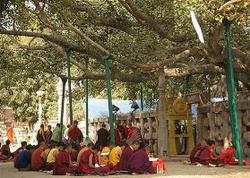Bodhi tree
Click here to see other articles relating to word Bodhi tree
Bodhi, a Pāḷi word meaning ‘awaken,’ is the name given to the particular tree growing at Bodh Gayā which The Buddha was sitting under when he became Enlightened.
This Bodhi Tree was a variety of fig known to botanists as Ficus religiosa and which has large spreading branches and rounded leaves with a characteristic pointed tip.
In the several accounts of The Buddha’s Enlightenment in the Tipiṭaka, the Bodhi Tree is only mentioned twice (D,II,4 and Ud.1, repeated at Vin.I,1-7). Tradition says that after his Enlightenment, The Buddha stood for seven days gazing at the Bodhi Tree out of Gratitude for the shelter it had given him (Ja.I,77), and modern Buddhists still revere this species of tree for the same reason.
Also, bo tree. The pipal tree (also spelled the peepul tree) at Buddhagaya, India, under which Shakyamuni Buddha attained Enlightenment.
In Sanskrit this variety of tree was called pippala or ashvattha.
It is a tall evergreen belonging to the mulberry family that reaches thirty meters in height.
Its leaves are Heart-shaped with an elongated, pointed end.
Because Shakyamuni attained Enlightenment under this tree, Buddhists came to regard it as sacred and refer to it as the Bodhi (Enlightenment) tree.
In early Buddhist sculptures, the Bodhi tree was used in carvings depicting the events of Shakyamuni Buddha's Life to symbolize Shakyamuni and his Enlightenment.
At that time, no representation of The Buddha himself was made in the carvings.
The Buddha was depicted symbolically as the Bodhi tree, and his teachings as the Wheel of the Law.
The present Bodhi Tree at Bodh Gayā was planted in 1880 and is distantly related to the original one.
Bodhi trees are sometimes mistakenly called banyans although the banyan is a different species of tree altogether.
The Bodhi Trees of the 28 Buddhas
The Pali Canon records some biographical information of the current Buddha, along with the previous Buddhas in known history.
Each Buddha attained enlightenment sitting under a tree.
All of the trees are considered Bodhi Trees but they were not all the same species of tree.
Bodhi tree: Also, Bo Tree. Tree beneath which the meditating Gautama sat before he achieved enlightenment.
According to tradition this was an Asvattha tree, though there is no historical evidence to support this belief.
It is widely believed to have been a Pipal tree, ficus religiosa, a large deciduous tree found in uplands and plains of India and Southeast Asia.
To this day, Buddhists make rosaries (malas) from the seed and plant the tree outside of temples.
Even the leaf is revered and sometimes carried as a charm.
The fruit contains serotonin and may have been used as an entheogen, although it is currently revered but rarely consumed.
Although a tropical tree, it can thrive as a houseplant, and is easy to grow as other ficus species.
This fast growing tree usually begins as an epiphyte (air plant, grows on trees) but develops roots to support its height of 90-plus feet.
Has purple figs, red flowers, and is different from other species, because of its slender, long leaf tip. See Pipal.

